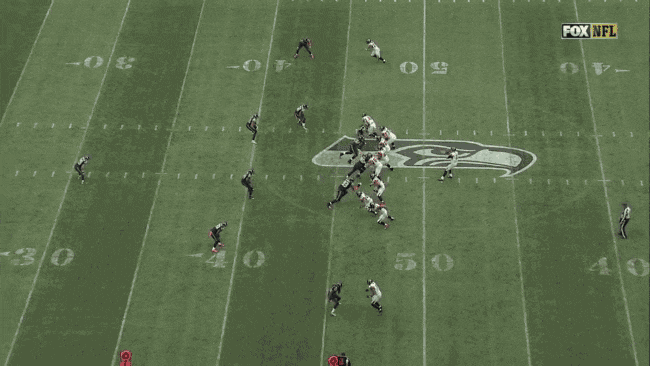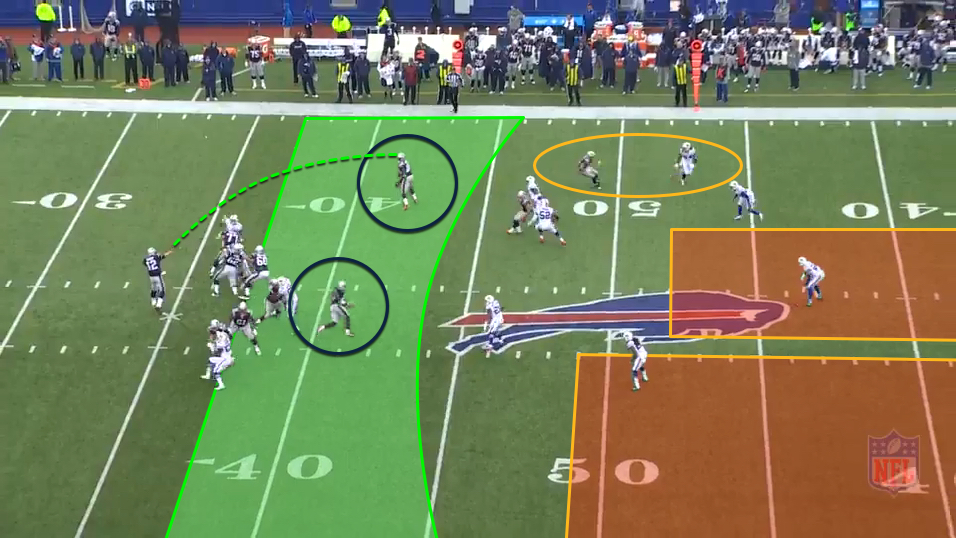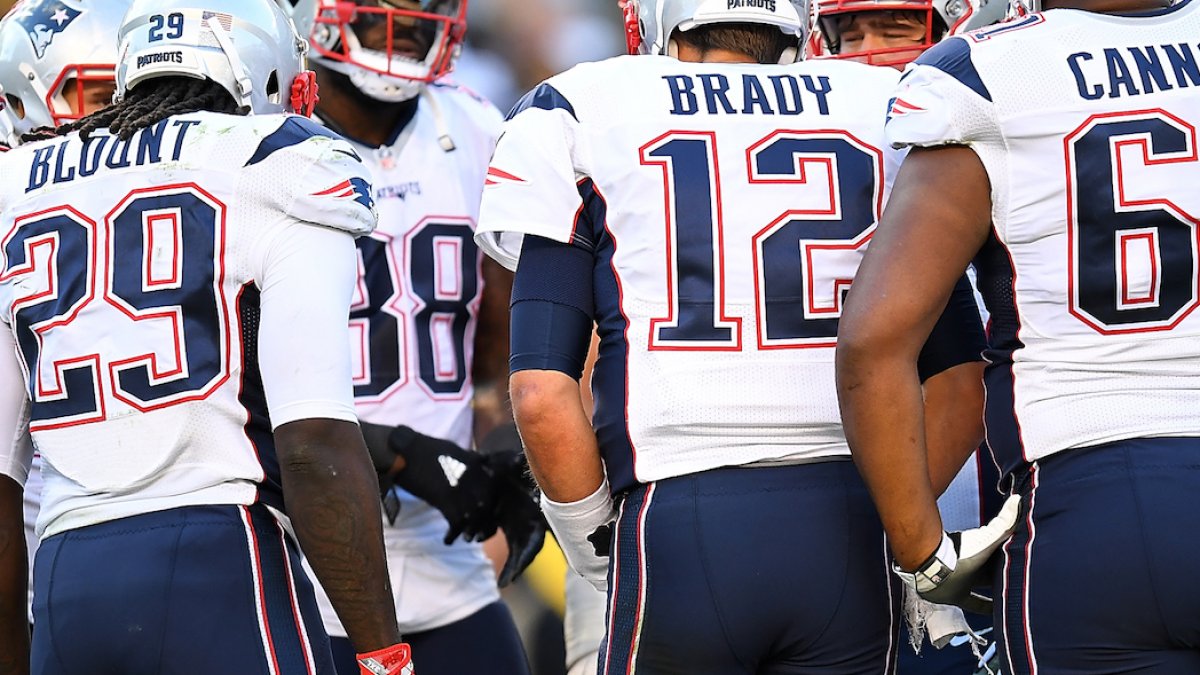New England versus Seattle isn’t just a classic matchup between a pair of perennial playoff contenders, or even a Super Bowl XLIX rematch, but rather a fascinating schematic battle between two units typically at the sharp end of league-wide rankings: the Patriots' offense agains the Seahawks' defense.
This will be the first meeting between the two teams since the Super Bowl that ended in such spectacular and controversial circumstances.
Heading into that game, the Seattle defense was again the top-ranked unit in the NFL, though perhaps not quite as fearsome as it had been the year before when it had been one of the all-time great defenses.
Still, they ranked first in most defensive categories, and hadn’t allowed 300 or more passing yards all season long. In the NFC Championship game, Aaron Rodgers and the Packers could manage just 178 passing yards, despite surrendering only seven total QB pressures against the Seahawks' rush.
As a team, Green Bay was not well equipped to attack Seattle’s defensive scheme—New England was.
Tom Brady passed for 325 yards in the Super Bowl, completed 73.5 percent of his passes, and had a passer rating of over 100.0, despite throwing a pair of interceptions.
This Patriots' offense is almost uniquely suited to being able to succeed against the Seahawks' defense, given how both sides set up.
Seattle’s defense plays a lot of cover-3 or cover-1. They mix and match zone and man coverage, and while many of their plays look the same, they have some complex rules when it comes to dealing with multiple receiver formations and alignments, so it can be difficult to diagnose for a QB.
Those complex assignments can actually be the Seahawks' undoing if an offense is good enough to identify them, as well as the bind they can place defenders in. Most teams, however, haven’t been able to do that. Atlanta this year, with inside knowledge coming from former Seahawks' defensive coordinator Dan Quinn, was able to put them in such a bind, and it caused a complete coverage bust on the touchdown to TE Levine Toilolo.

Even so, an offense that has averaged 35 points over the rest of the season (despite playing the Denver Broncos) put up just 24 against the Seahawks.
What the Seattle defense typically does by alignment is try and keep everything underneath them. Cover-3 puts three defenders in deep zones over the top of the defense, with the middle of the field “closed” by a free safety—usually Earl Thomas, a player with unique range from that spot. That free safety effectively takes away any post pattern, and the range of Thomas—coupled with the deep zones on the edge—ward off any other deep pattern.
When the Seahawks play man coverage, it forces offenses to challenge some elite coverage defenders, like Richard Sherman, a player who will likely punish you with a turnover if you attack him often enough.
Take this play from Monday night against the Bills.

Buffalo has four receivers out in pass patterns, and the Seahawks have defenders over the top of all of them. The deep ball isn’t there, and with zone defenders dropping under the routes, the intermediate windows are tight. The space is all underneath, and this is what Seattle wants to do to an offense. The only realistic place to go with the football before pressure gets there is a dump-off to the running back after QB Tyrod Taylor escapes pressure.
For most teams, that’s an offensive failure. NFL offenses don’t want to complete passes for 3–6 yards, even though three of those likely moves the chains and keeps the drive alive.
Most teams simply aren’t efficient enough to be able to do it. All the Seahawks need to do is break up one of those passes and the offense is behind the chains —a dropped pass or a miss from the QB can do the same. If you’re looking to pick up yards in incredibly small increments, you need to be efficient enough to make it happen time and time again, or the defense ultimately wins. That’s Seattle’s overall game plan: force teams to pass underneath and play the percentages, or bank on it frustrating them enough that they take an ill-advised shot against an opportunistic defense.
The Patriots, as you might expect, do things differently.
This is a team that is perfectly prepared to kill a defense with a thousand paper cuts. The Patriots really hit their stride with this approach with the acquisition of Wes Welker from Miami for the 2007 season, but the legacy has continued since his departure.
Arguably Tom Brady’s biggest asset is endless patience. He was able to go deep almost at will in 2007 because he had Randy Moss, but the team really hasn’t had a legitimate deep threat since, and has gone entire seasons with no discernible deep passing to back off a defense. Brady has to be prepared some games to pick up yardage in excruciatingly small chunks, and just keep taking what the defense gives him, passing to the correct option knowing that if he does it enough without making a mistake, it will lead New England into scoring range.
This is torture for most quarterbacks, and eventually, they almost all make a mistake, or force a throw they shouldn’t. Brady, however, will do it all day because he understands that it can be the best way to win games.
Take this play against Buffalo a couple of weeks ago:

The Bills are giving broadly the same look that we saw earlier from Seattle, but the Patriots have routes in the underneath areas and the ball is already in the air. This play picked up 5 yards on 2nd-and-11, and would be a bust for most offenses, but the Patriots were happy to take it. They gained 8 yards on the next play and kept on trucking. The drive ultimately ended in a touchdown, after 15 plays of slow, incremental gains.
In Super Bowl XLIX, Brady may have passed for over 300 yards, but he didn’t have a completion of more than 23 on any one play. Five different players saw seven or more targets, and despite a pair of drops, Brady’s completion percentage was over 70.0. Adjust for those drops and the throwaway, and he was accurate on 80.9 percent of his passes, more than 20 percent better than Russell Wilson in the same game.
The Seahawks' defense is once again excellent in 2016. It isn’t quite been as dominant as the units from 2013 or 2014, but it has still yet to allow anybody to score more than 25 points in a game. The Arizona Cardinals—a team that wants to attack deep—were completely neutralized by Seattle's tactics, scoring just six points in the entire game through five full quarters on their way to a tie. The high-flying Atlanta Falcons offense, despite inside knowledge of the defense and ways to exploit it, managed just 25 points and effectively only beat them once.
This defense is still one of the league’s most formidable, and one of the most schematically effective in the league; but once again, the Patriots could prove to be its kryptonite.
Brady is playing as well as he ever has in his Hall of Fame career, and is making plays with staggering efficiency. He has yet to throw an interception since his return from suspension, and owns the league’s best completion percentage, at 73.1 percent. Adjusting for drops, spikes, etc., he has been accurate on 87.4 percent of his passes, a full 7 percent better than any other QB. That’s the same gap as the one between the No. 2 and No. 18 QBs in the league in the same category.
Brady was able to pick this defense apart in the Super Bowl in a way that they hadn’t seen before that season. What’s worrying for the Seahawks this time around is that Brady is playing better now than he was then, and the Seattle defense isn't performing quite at that same level.



 © 2024 PFF - all rights reserved.
© 2024 PFF - all rights reserved.